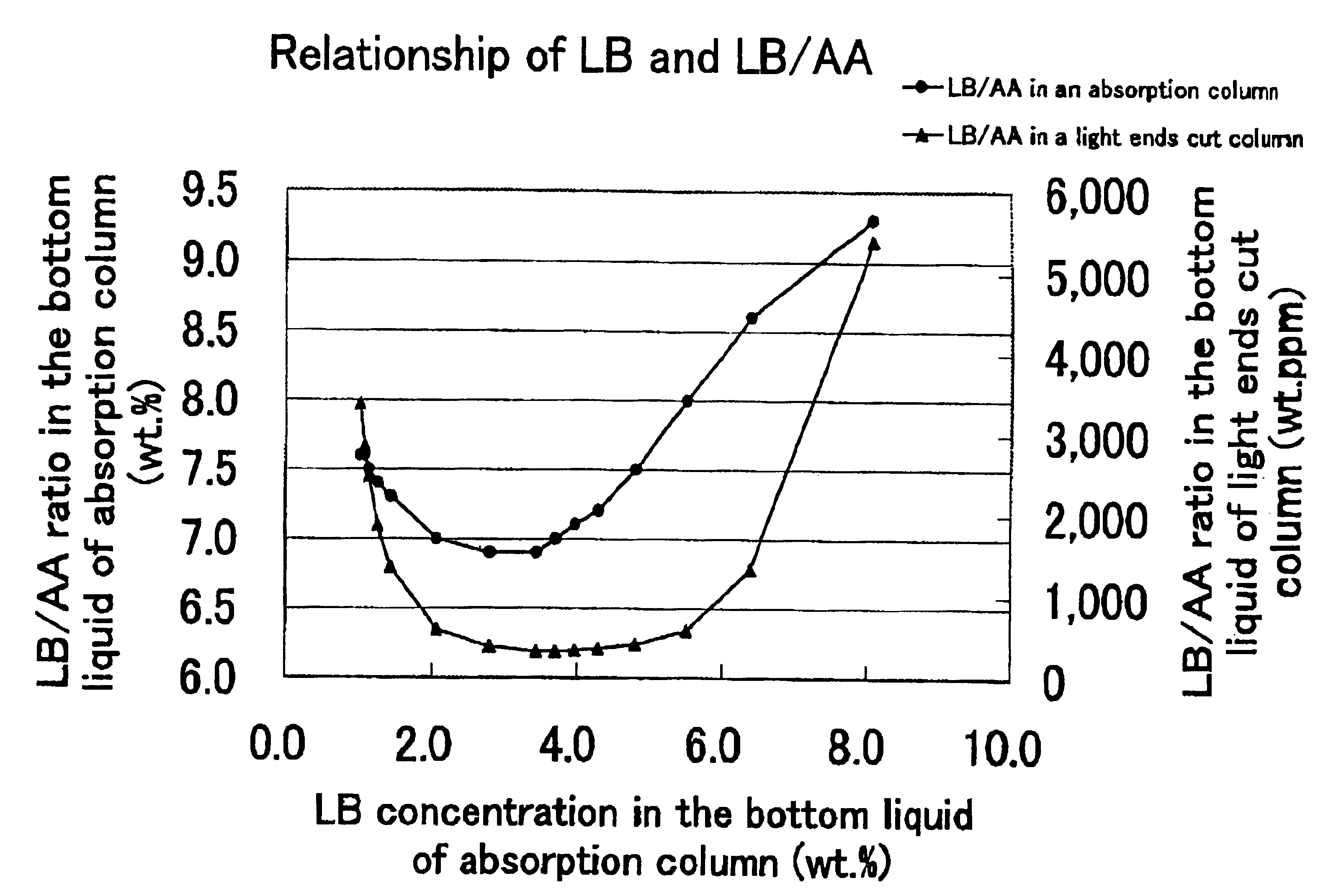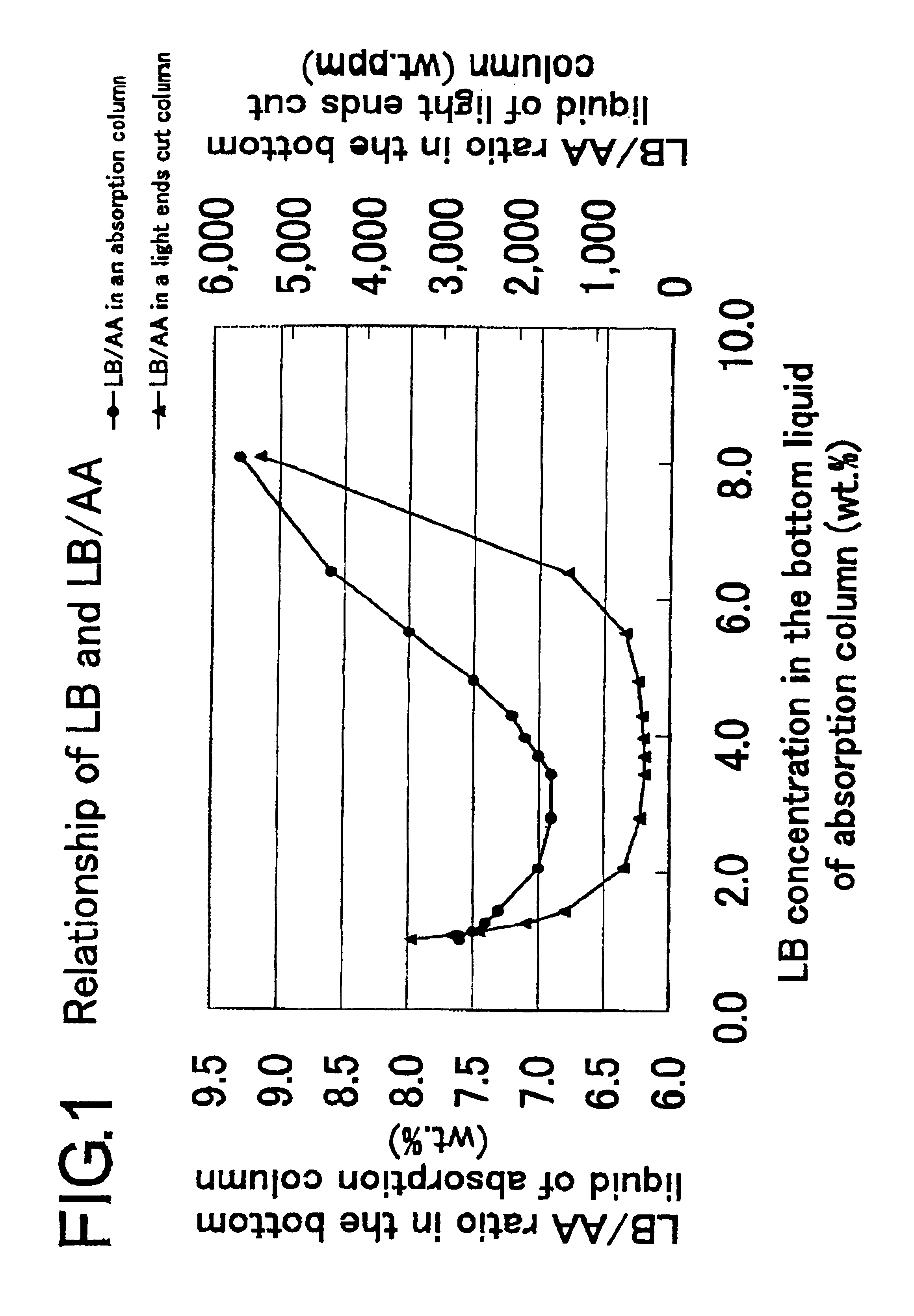Method for absorbing acrylic acid and method for purifying acrylic acid
a technology of acrylic acid and acrylic acid, which is applied in the preparation of carboxylic compounds, separation processes, organic chemistry, etc., can solve the problems of large volume of energy required to remove low boiling substances, difficult separation large volume of energy required to achieve the removal of low boiling substances, the effect of absorbing coefficient and low boiling substances
- Summary
- Abstract
- Description
- Claims
- Application Information
AI Technical Summary
Benefits of technology
Problems solved by technology
Method used
Image
Examples
example 1
[0078]In accordance with the process depicted in FIG. 2, acrylic acid was purified through the step for preparation of an acrylic acid-containing gas by the reaction of catalytic gas phase oxidation and the subsequent use of an acrylic acid absorption column, a light ends cut column, and a heavy ends cut column.
[0079](1) By the reaction of catalytic gas phase oxidation, an acrylic acid-containing gas composed of 7.15 vol. % of acrylic acid, 14.6 vol. % of low boiling substances (total of formic acid, acetic acid, acrolein, formaldehyde, acetaldehyde, and water), 0.15 vol. % of high boiling substances (total of furfural and maleic anhydride), and 78.1 vol. % of uncondensing gas (total of nitrogen, oxygen, propylene, propane, carbon monoxide, and carbon dioxide) was obtained.
[0080](2) The acrylic acid-containing gas was supplied to the acrylic acid absorption column. The temperature at which the acrylic acid-containing gas was supplied was 150° C. The acrylic acid absorption column me...
example 2
[0084](1) An acrylic acid-containing gas having the same composition as in Example 1 was prepared.
[0085](2) Then, the acrylic acid-containing gas was supplied to the acrylic acid absorption column. The acrylic acid absorption column and the absorbent used herein were the same as those used in Example 1. The temperature at which the acrylic acid-containing gas was supplied was 150° C. similarly in Example 1 and the feed rate of the gas to the acrylic acid absorption column was 8.14 Nm3 / h. When the absorption of acrylic acid was effected by setting the flow rate of the absorbent at 1.1 kg / h (0.6 times the mass flow rate of the acrylic acid), the column top pressure at 11.7 kPa (gauge pressure), and the column top temperature at 41.2° C., the absorbing coefficient of acrylic acid was 98.1 weight %, the concentration of acrylic acid in the bottoms was 59.9 weight %, and the concentration of the low boiling substance relative to acrylic acid was 7.2 weight %.
[0086](3) The bottoms of the ...
example 3
[0088](1) An acrylic acid-containing gas having the same composition as in Example 1 was prepared.
[0089](2) Then, the acrylic acid-containing gas was supplied to the acrylic acid absorption column. The acrylic acid absorption column and the absorbent used herein were the same as those in Example 1. The temperature at which the acrylic acid-containing gas was supplied was 150° C. similarly in Example 1 and the feed rate of this gas to the acrylic acid absorption column was 8.14 Nm3 / h. When the absorption of acrylic acid was effected by setting the flow rate of the absorbent at 7.5 kg / h (4.0 times the mass flow rate of the acrylic acid), the column top pressure at 11.7 kPa (gauge pressure), and the column top temperature at 53.8° C., the absorbing coefficient of acrylic acid was 98.1 weight %, the concentration of acrylic acid in the bottoms was 19.7 weight %, and the concentration of the low boiling substance relative to acrylic acid was 7.3 weight %.
[0090](3) The bottoms were suppli...
PUM
| Property | Measurement | Unit |
|---|---|---|
| temperature | aaaaa | aaaaa |
| temperature | aaaaa | aaaaa |
| temperature | aaaaa | aaaaa |
Abstract
Description
Claims
Application Information
 Login to View More
Login to View More - R&D
- Intellectual Property
- Life Sciences
- Materials
- Tech Scout
- Unparalleled Data Quality
- Higher Quality Content
- 60% Fewer Hallucinations
Browse by: Latest US Patents, China's latest patents, Technical Efficacy Thesaurus, Application Domain, Technology Topic, Popular Technical Reports.
© 2025 PatSnap. All rights reserved.Legal|Privacy policy|Modern Slavery Act Transparency Statement|Sitemap|About US| Contact US: help@patsnap.com



